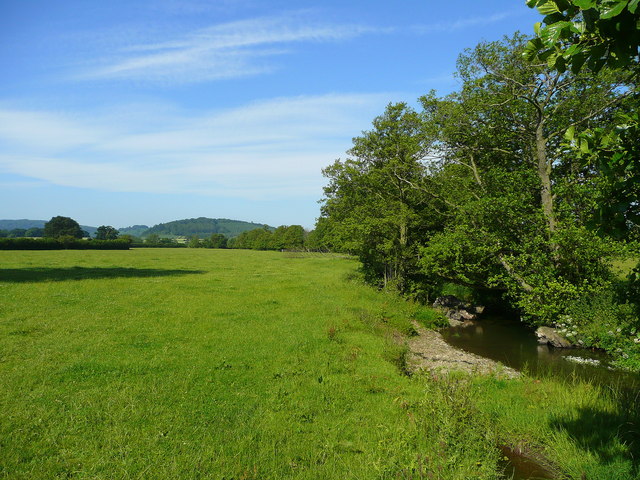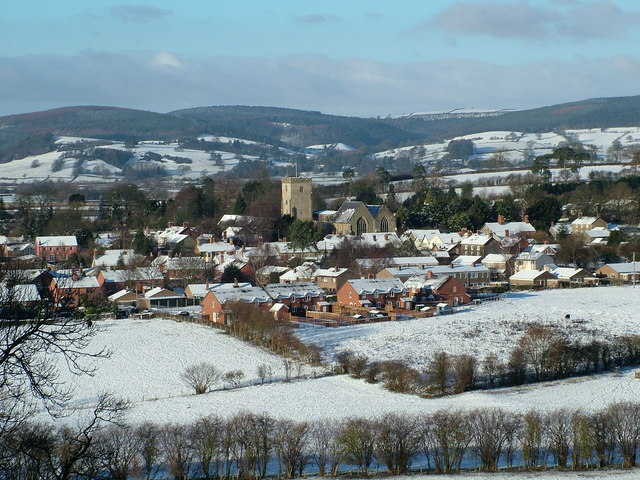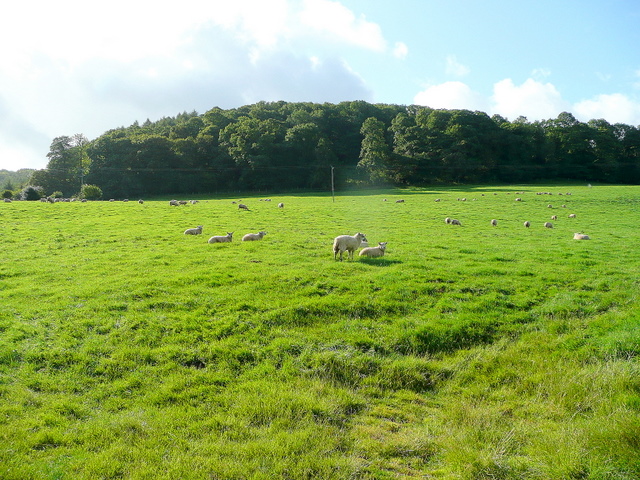|
Buckton Roman Fort
Buckton Roman Fort is an archaeological site at Buckton, about 1 mile south-west of Leintwardine, in Herefordshire. England. it is a scheduled monument. Description The Roman ''vicus'' Bravonium was established at present-day Leintwardine about AD 70; a fort was built there about AD 160, and abandoned about AD 196. The fort at Buckton is just above the floodplain of the River Teme. The remains, entirely buried, were observed and photographed from the air by W A Baker in 1959, during a drought. There was excavation between then and 1961, from which a chronology was established. Originally there were turf ramparts and timber gate towers, constructed about AD 80. The fort replaced an earlier fort nearby at Jay Lane. It is thought that this site had a better water supply; traces of a bath house Public baths originated when most people in population centers did not have access to private bathing facilities. Though termed "public", they have often been restricted according to gender ... [...More Info...] [...Related Items...] OR: [Wikipedia] [Google] [Baidu] |
Buckton And Coxall
Buckton and Coxall is a civil parish in north Herefordshire, England. Buckton and Coxall are hamlets in the parish. Coxall has a Baptist chapel situated on the B4367 road, where there is a Royal Mail post box too. The chapel and post box are on the other side of the Heart of Wales Line from the main part of the hamlet, and in the county of Shropshire. Buckton is a larger hamlet and has a bridge (Buckton Bridge) over the River Teme.Ordnance Survey mapping There was a Roman fort at Buckton. Adley Moor (or Adleymoor) is another small hamlet in the parish and lies between Coxall and Jay (a small hamlet in neighbouring Leintwardine civil parish). Between Adley Moor and Jay is a small piece of common land (Adley Moor/Adleymoor Common). The River Redlake flows through the parish, passing Coxall and Adley Moor, before joining the River Clun at Jay. The Herefordshire Trail long distance footpath passes through the southern part of the parish, on its way between the nearby Herefordshi ... [...More Info...] [...Related Items...] OR: [Wikipedia] [Google] [Baidu] |
Leintwardine
Leintwardine ( ) is a small to mid-size village and civil parish in north Herefordshire, England, close to the border with Shropshire. History Roman A popular misconception is that the Romans called the village ''Branogenium''. Branogenium in fact refers to a Roman fort roughly south of the village. The Roman name for Leintwardine was actually ''Bravonium''. The High Street in Leintwardine is on the same line as the Roman road known (to the English) as Watling Street. (The modern-day street in the village named Watling Street runs to the east of the original Watling Street, roughly on the alignment of the eastern edge of the Roman settlement.) The name Bravonium, as it appears in the Antonine Itinerary (Iter XII), is derived from the Romano-British word for quern. This suggests that there was either a hill or rock formation here that looked like a quern, or that there were quern quarries nearby. In the Upper Silurian series, the Leintwardine beds outcrop in the area and these c ... [...More Info...] [...Related Items...] OR: [Wikipedia] [Google] [Baidu] |
Herefordshire
Herefordshire () is a county in the West Midlands of England, governed by Herefordshire Council. It is bordered by Shropshire to the north, Worcestershire to the east, Gloucestershire to the south-east, and the Welsh counties of Monmouthshire and Powys to the west. Hereford, the county town of Herefordshire has a population of approximately 61,000, making it the largest settlement in the county. The next biggest town is Leominster and then Ross-on-Wye. The county is situated in the historic Welsh Marches, Herefordshire is one of the most rural and sparsely populated counties in England, with a population density of 82/km2 (212/sq mi), and a 2021 population of 187,100 – the fourth-smallest of any ceremonial county in England. The land use is mostly agricultural and the county is well known for its fruit and cider production, and for the Hereford cattle breed. Constitution From 1974 to 1998, Herefordshire was part of the former non-metropolitan county of Hereford and Wor ... [...More Info...] [...Related Items...] OR: [Wikipedia] [Google] [Baidu] |
Roman Britain
Roman Britain was the period in classical antiquity when large parts of the island of Great Britain were under occupation by the Roman Empire. The occupation lasted from AD 43 to AD 410. During that time, the territory conquered was raised to the status of a Roman province. Julius Caesar invaded Britain in 55 and 54 BC as part of his Gallic Wars. According to Caesar, the Britons had been overrun or culturally assimilated by other Celtic tribes during the British Iron Age and had been aiding Caesar's enemies. He received tribute, installed the friendly king Mandubracius over the Trinovantes, and returned to Gaul. Planned invasions under Augustus were called off in 34, 27, and 25 BC. In 40 AD, Caligula assembled 200,000 men at the Channel on the continent, only to have them gather seashells ('' musculi'') according to Suetonius, perhaps as a symbolic gesture to proclaim Caligula's victory over the sea. Three years later, Claudius directed four legi ... [...More Info...] [...Related Items...] OR: [Wikipedia] [Google] [Baidu] |
Scheduled Monument
In the United Kingdom, a scheduled monument is a nationally important archaeological site or historic building, given protection against unauthorised change. The various pieces of legislation that legally protect heritage assets from damage and destruction are grouped under the term "designation." The protection provided to scheduled monuments is given under the Ancient Monuments and Archaeological Areas Act 1979, which is a different law from that used for listed buildings (which fall within the town and country planning system). A heritage asset is a part of the historic environment that is valued because of its historic, archaeological, architectural or artistic interest. Only some of these are judged to be important enough to have extra legal protection through designation. There are about 20,000 scheduled monuments in England representing about 37,000 heritage assets. Of the tens of thousands of scheduled monuments in the UK, most are inconspicuous archaeological sites, but ... [...More Info...] [...Related Items...] OR: [Wikipedia] [Google] [Baidu] |
Vicus
In Ancient Rome, the Latin term (plural ) designated a village within a rural area () or the neighbourhood of a larger settlement. During the Republican era, the four of the city of Rome were subdivided into . In the 1st century BC, Augustus reorganized the city for administrative purposes into 14 regions, comprising 265 . Each had its own board of officials who oversaw local matters. These administrative divisions are recorded as still in effect at least until the mid-4th century. The word "" was also applied to the smallest administrative unit of a provincial town within the Roman Empire. It is also notably used today to refer to an ''ad hoc'' provincial civilian settlement that sprang up close to and because of a nearby military fort or state-owned mining operation. Local government in Rome Each ''vicus'' elected four local magistrates ('' vicomagistri'') who commanded a sort of local police force chosen from among the people of the ''vicus'' by lot. Occasionally the o ... [...More Info...] [...Related Items...] OR: [Wikipedia] [Google] [Baidu] |
River Teme
The River Teme (pronounced ; cy, Afon Tefeidiad) rises in Mid Wales, south of Newtown, and flows southeast roughly forming the border between England and Wales for several miles through Knighton before entering England in the vicinity of Bucknell and continuing east to Ludlow in Shropshire. From there, it flows to the north of Tenbury Wells on the Shropshire/Worcestershire border on its way to join the River Severn south of Worcester. The whole of the River Teme was designated as an SSSI by English Nature in 1996. The river is crossed by a number of historic bridges including one at Tenbury Wells that was rebuilt by Thomas Telford following flood damage in 1795. It is also crossed, several times, by the Elan aqueduct. Etymology The name Teme is similar to many other river names in England, testament to the name's ancient origin. Similar names include River Team, River Thames, River Thame, River Tame and River Tamar. Scholars now believe these names and the older names Te ... [...More Info...] [...Related Items...] OR: [Wikipedia] [Google] [Baidu] |
Jay, Herefordshire
Jay is a hamlet in north Herefordshire, England. It lies in the civil parish of Leintwardine, on the other side of the River Clun northwest of that village. The lane between Jay and Leintwardine is called Jay Lane and the bridge over the Clun is Jay Bridge. The minor River Redlake passes Jay and then joins the Clun just south of Jay Bridge.Ordnance Survey mapping The hamlets of Jay and nearby Heath formed a single township and whilst in the present day form part of the civil parish of Leintwardine, and thus a part of Herefordshire, they were regarded as being part of Shropshire until the mid-19th century. A Roman auxiliary cavalry fort was situated at Jay Lane. Jay Lane Its name, and that of the nearby hamlet of |
Thermae
In ancient Rome, (from Greek , "hot") and (from Greek ) were facilities for bathing. usually refers to the large Roman Empire, imperial public bath, bath complexes, while were smaller-scale facilities, public or private, that existed in great numbers throughout Rome. Most Roman cities had at least one – if not many – such buildings, which were centers not only for bathing, but socializing and reading as well. Bathhouses were also provided for wealthy private Roman villa, villas, domus, town houses, and castra, forts. They were supplied with water from an adjacent river or stream, or within cities by aqueduct (watercourse), aqueduct. The water would be heated by fire then channelled into the caldarium (hot bathing room). The design of baths is discussed by Vitruvius in ''De architectura'(V.10) Terminology '','' '','' '','' and may all be translated as 'bath' or 'baths', though Latin sources distinguish among these terms. or , derived from the Greek language, G ... [...More Info...] [...Related Items...] OR: [Wikipedia] [Google] [Baidu] |
Roman Cavalry
Roman cavalry (Latin: ''equites Romani'') refers to the horse-mounted forces of the Roman army throughout the Regal, Republican, and Imperial eras. In the Regal era the Roman cavalry was a group of 300 soldiers called '' celeres'', tasked with guarding the king. Later their numbers were doubled to 600, then possibly 1,800. All of the cavalrymen were patricians. In the Republican era, the general name for the cavalry was Equites and consisted of the Equites class and the First Class, with a group of 300 cavalrymen in every legion. They were divided into 10 groups of 30 men. Each group elected three leaders known as ''decuriones''. Later the Roman cavalry stopped using Roman citizens as cavalrymen and relied on Auxilia and foreign recruits. Roman cavalrymen wore a Corinthian helmet, bronze chestplate, and bronze greaves. Later mail was adopted into the army. Their arms included a lance ('' lanceae''), a long sword (''spatha''), and short throwing spears (''akontes''). Hist ... [...More Info...] [...Related Items...] OR: [Wikipedia] [Google] [Baidu] |
Roman Sites In England
Roman or Romans most often refers to: *Rome, the capital city of Italy *Ancient Rome, Roman civilization from 8th century BC to 5th century AD *Roman people, the people of ancient Rome *''Epistle to the Romans'', shortened to ''Romans'', a letter in the New Testament of the Christian Bible Roman or Romans may also refer to: Arts and entertainment Music * Romans (band), a Japanese pop group * ''Roman'' (album), by Sound Horizon, 2006 * ''Roman'' (EP), by Teen Top, 2011 *" Roman (My Dear Boy)", a 2004 single by Morning Musume Film and television *Film Roman, an American animation studio * ''Roman'' (film), a 2006 American suspense-horror film * ''Romans'' (2013 film), an Indian Malayalam comedy film * ''Romans'' (2017 film), a British drama film * ''The Romans'' (''Doctor Who''), a serial in British TV series People *Roman (given name), a given name, including a list of people and fictional characters *Roman (surname), including a list of people named Roman or Romans *Ῥωμα� ... [...More Info...] [...Related Items...] OR: [Wikipedia] [Google] [Baidu] |
Scheduled Monuments In Herefordshire
There are 273 scheduled monuments in the county of Herefordshire, England. These scheduled monument, protected sites date from the Neolithic period in some cases and include Tumulus, barrows, churchyard crosses, ruined abbeys, castles, and Iron Age Hillforts in Britain, hill forts. In the United Kingdom, the scheduling of monuments was first initiated to ensure the preservation of "nationally important" archaeological sites or historic buildings. Protection is given to scheduled monuments under the Ancient Monuments and Archaeological Areas Act 1979. Notable scheduled monuments in Herefordshire See also *Grade I listed buildings in Herefordshire *List of scheduled monuments, List of scheduled monuments in the United Kingdom References {{Herefordshire Scheduled monuments in Herefordshire Lists of scheduled monuments in England, Herefordshire ... [...More Info...] [...Related Items...] OR: [Wikipedia] [Google] [Baidu] |







